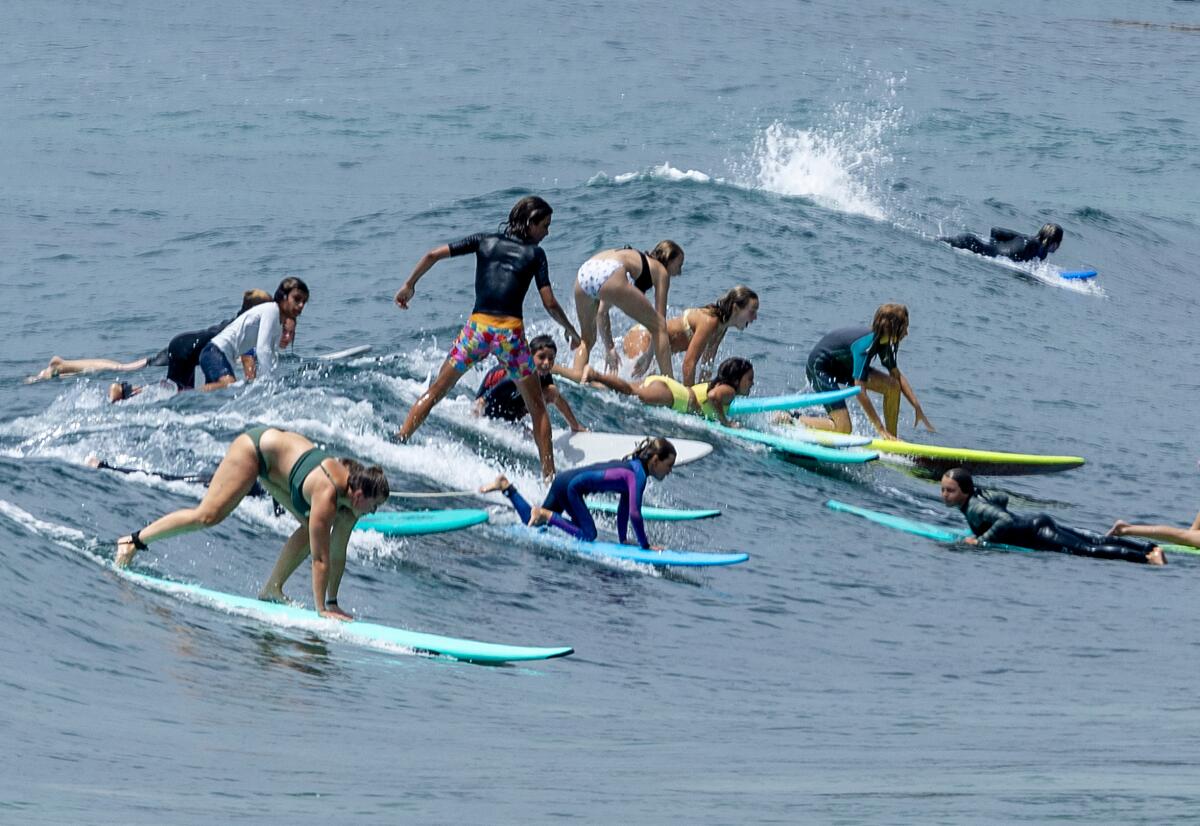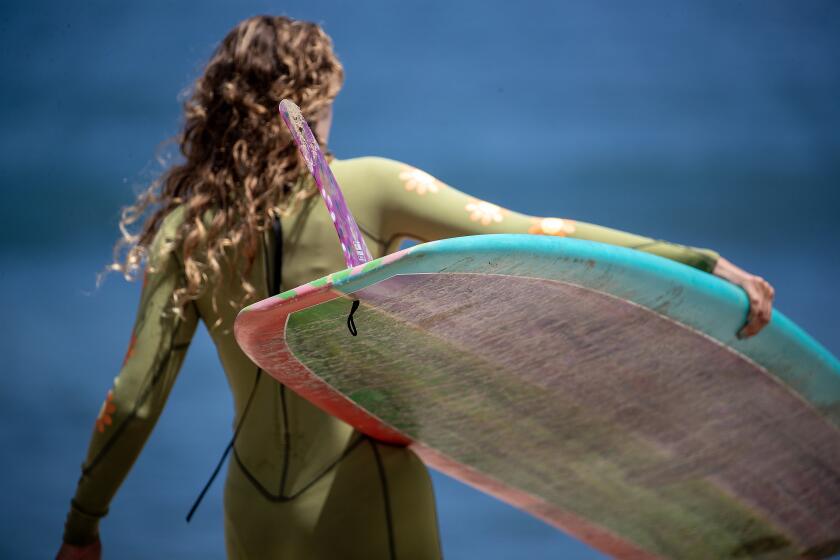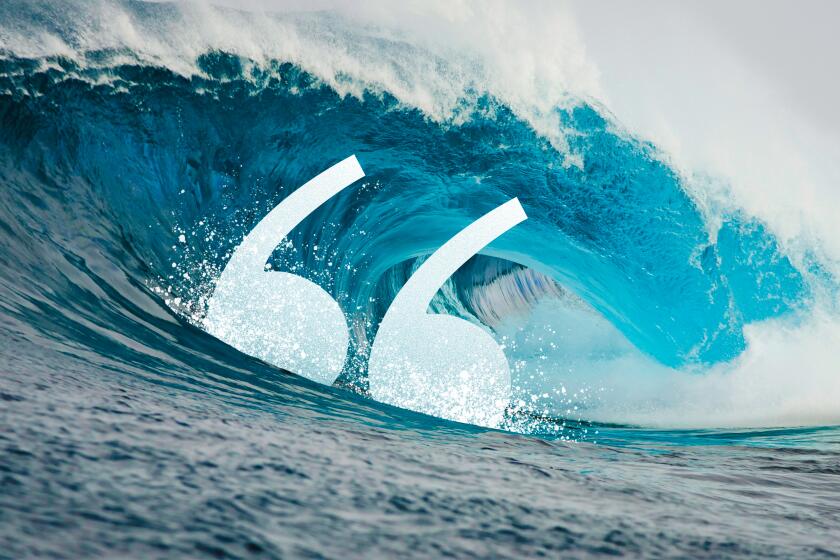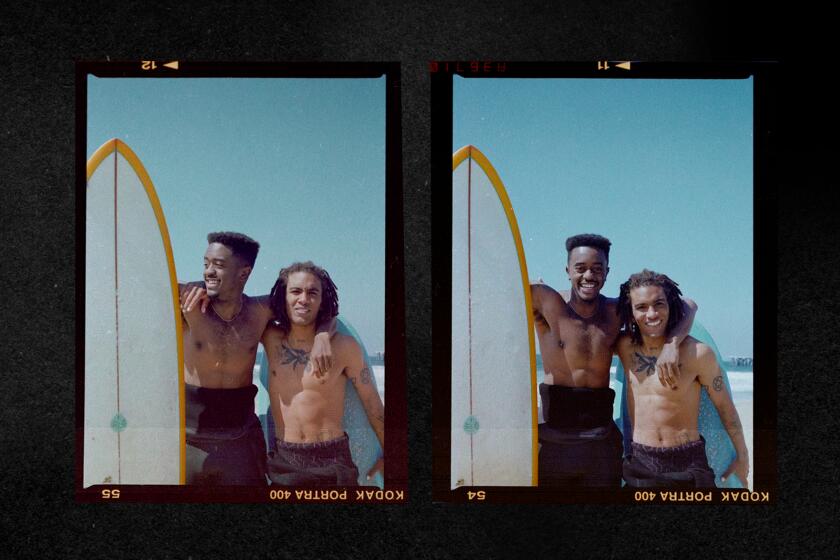Think you’re ready to surf in SoCal? Here’s how to avoid angering the lineup

- Share via
It’s no secret that the surfer population in Southern California has exploded in recent years as people sought new outdoor experiences during the height of the COVID-19 pandemic. It’s also no secret that it can get rough and tumble on the waves these days. That’s why more and more surfers are preaching surf etiquette, a set of informal guidelines and if-you-know, you-know rules.
“Lineups have become more crowded and more dangerous. Beginner surfers that do not know surfing etiquette were paddling out at places like Rincon and Trestles before learning the basics and becoming strong paddlers. This has caused a lot of frustration and injury for more experienced surfers,” said Christian Glasgow, sports performance and counseling psychologist for the World Surf League, referring to popular spots in Santa Barbara and San Clemente. “I have quite a few patients that have been injured in the last few years due to being hit by a surfboard, including significant brain injuries.”
Many Southern Californians have picked up soft top surfboards, joined surf camps or purchased daily lessons to be part of what’s often seen as a carefree lifestyle. But all that stereotypical chill dissipates in a crowded lineup.
Following surf etiquette can prevent injury and make the waves safer and more enjoyable for all. Rules vary from break to break, but there are some basic guidelines everyone should know.
1. Know your ability
Whether surfing is second nature or new territory, always consider how your skill level relates to the surf conditions. If you’ve never surfed or you’re still learning, take lessons from reputable surf schools, said Amy Reda, co-owner of Endless Sun Surf School. Lacking knowledge about the sport and experience in the water can put you and others at risk. And, of course, when in doubt, don’t paddle out.
For the record:
4:16 p.m. Sept. 5, 2023An earlier version of this article incorrectly stated that Amy Reda is the co-owner of Endless Summer Surf School. She is the co-owner of Endless Sun Surf School.
“Real life etiquette and safety scenarios will come up during the [surf] lesson so that professional instructors can accurately and safely assess and teach the correct responses,” said Reda.
Whether you’ve got the latest surfboard prototype or a $100 soft top, get your fix at SoCal surf spots. Newbies beware: Surfers are hungry for waves after a wet spring.
2. Understand the break and conditions
Many environmental factors can make or break a session, including the tide, currents, wind, types of surf breaks and the swell direction and size. These conditions can change at a moment’s notice, depending on the type of surf break. Understanding these factors can help you determine the most ideal spot to paddle out into the lineup — and whether it’s safe to join the fray at all. Once you understand the break and its conditions, you can avoid paddling out in front of breaking waves, into shallow areas and in front of other surfers catching waves.
“Know the conditions, know what the currents are doing, what the waves and wind are doing, if there’s an incoming swell,” said Crystal Thornburg-Homcy, Patagonia surfing ambassador and director of the documentary “Beyond the Surface.” “I think that’s where some people make their first mistake. They can get in over their head because they don’t really understand the ocean or what it’s doing or where to go or how to deal with these conditions.”
3. Observe and respect others
Whether you’re a regular or someone who just flew in from the other side of the world, it’s important to observe and respect others in the water at all times. Surfers often line up to a wave’s peak similar to waiting in line for a theme park ride, hence the term “lineup.” With this in mind, surfers must observe and respect those who are closest to the peak, who are taking off on a wave and who may be struggling to catch waves.
“Always look to the peak and ask yourself, ‘Where’s the wave starting? Is there someone that has priority over me?’ and respect it,” said Thornburg-Homcy. “It’s like crossing the street. Look both ways. You’re not just going to run across the freeway, right? Be mindful and aware of your surroundings.”
There’s plenty of trash talk and hot goss in the surfing lineup. Here’s what was overheard while taking off at Southern California beaches.
4. Take turns and respect the right of way
The person closest to the peak of the wave has the right of way. Do not drop in or cut off another surfer’s turn. Surfers have a knack for focusing on the sheer excitement and adrenaline rush that comes with catching a wave — it’s addictive. As a result, tunnel vision (or outright territoriality) sets in, and surfers will paddle back to the lineup for another wave … and then another. However, this can lead to resentment and result in lashing out or fights.
“Look left and right. And then do it again. This is a very common beginner mistake that people are very unaware that they are making,” said Reda. “Many beginners will blindly paddle for a wave and not look to see if someone is already up and coming their way. And if someone is, put on your brakes and back off the wave immediately.”
5. Communicate and offer help
When it’s your turn to take off on a wave, make sure people know the direction you plan to surf. Communicate in advance by calling out “going left” or “going right” to the lineup. Many accidents and injuries occur as a result of poor communication. If injuries happen or a fellow surfer is struggling, make sure to help that person to safety.
“A lot of people are nervous about surfing because they’re nervous about the waves. They’re nervous about new places and they’re just trying to get their bearings,” said Kassia Meador, founder of Kassia + Surf, a wetsuit brand made for women by women. “And if they get a couple dirty looks, then that’s not supportive.” Meador suggests acknowledging people with a smile to make them feel welcome. And if new people look like they’re struggling or need help, ask them.
6. Be open to feedback
It’s always OK to ask for a few pointers. You should also be open to constructive feedback. You may be branded “nonlocal” after you take off in the wrong direction or paddle out in the worst possible spot. Apologize, learn from your mistakes and adjust.
“The first rule in conflict resolution is to take responsibility for your part of the conflict. If you do break a rule and upset or injure another surfer in the water, I recommend you disarm the situation and take responsibility. In many cases, this isn’t about respect, it really just comes down to safety,” said Glasgow. “If that doesn’t work, it might be important to allow a short-fused local to vent, then acknowledge and validate what they have expressed. If that is not working, paddling in and trying again another day might also be the best way to handle the situation to avoid a possible physical confrontation.”
Getting called a racial slur while surfing Manhattan Beach changed how Justin ‘Brick’ Howze and Gage Crismond view their role in the sport.
7. Don’t ditch your board
Before paddling out, learn how to hold onto your board through more powerful surf. Moves like the turtle roll or duck dive — techniques that help you push your board through the white water — can help. A flailing surfboard, no matter its size, can cause serious injury to yourself and others.
“If you are wearing a leash, don’t let that give you a false sense of safety,” said Reda. “It can most definitely still hit someone if you ditch your board. Learn how to hang on to your board with your hands.”
Overall, be safe and respectful when paddling out. And don’t forget one last tip: Have fun.
More to Read
Sign up for The Wild
We’ll help you find the best places to hike, bike and run, as well as the perfect silent spots for meditation and yoga.
You may occasionally receive promotional content from the Los Angeles Times.













